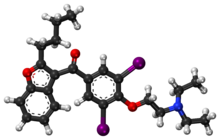Amiodarone
 |
|
 |
|
| Clinical data | |
|---|---|
| Pronunciation | /əˈmiːoʊdəˌroʊn/ |
| Trade names | Cordarone, Nexterone, others |
| AHFS/Drugs.com | Monograph |
| MedlinePlus | a687009 |
| Pregnancy category |
|
| Routes of administration |
or intravenous |
| ATC code | |
| Legal status | |
| Legal status |
|
| Pharmacokinetic data | |
| Bioavailability | 20–55% |
| Metabolism | Liver |
| Biological half-life | 58 d (range 15-142 d) |
| Excretion | Primarily liver and bile |
| Identifiers | |
|
|
| CAS Number | |
| PubChem CID | |
| IUPHAR/BPS | |
| DrugBank | |
| ChemSpider | |
| UNII | |
| KEGG | |
| ChEBI | |
| ChEMBL | |
| ECHA InfoCard | 100.016.157 |
| Chemical and physical data | |
| Formula | C25H29I2NO3 |
| Molar mass | 645.31 g/mol |
| 3D model (Jmol) | |
|
|
|
|
Amiodarone is an antiarrhythmic medication used to treat and prevent a number of types of irregular heartbeats. This includes ventricular tachycardia (VT), ventricular fibrillation (VF), and wide complex tachycardia, as well as atrial fibrillation and paroxysmal supraventricular tachycardia. It can be given by mouth, intravenously, or intraosseously. When used by mouth it can take a few weeks for effects to begin.
Common side effects include feeling tired, tremor, nausea, and constipation. As amiodarone can have serious side effects, it is mainly recommended only for significant ventricular arrhythmias. Serious side effects include lung toxicity such as interstitial pneumonitis, liver problems, heart arrhythmias, vision problems, thyroid problems, and death. If taken during pregnancy or breastfeeding it can cause problems in the baby. It is a class III antiarrhythmic medication. It works partly by increasing the time before a heart cell can contract again.
Amiodarone was first made in 1961 and came into medical use in 1962 for chest pain believed to be related to the heart. It was pulled from the market in 1967 due to side effects. In 1974 it was found to be useful for arrhythmias and reintroduced. It is on the World Health Organization's List of Essential Medicines, the most effective and safe medicines needed in a health system. It is available as a generic medication. In the developing world the wholesale cost as of 2014 is about 0.06 to 0.26 USD per day. In the United States a typical month supply is between 100 and 200 USD.
...
Wikipedia
